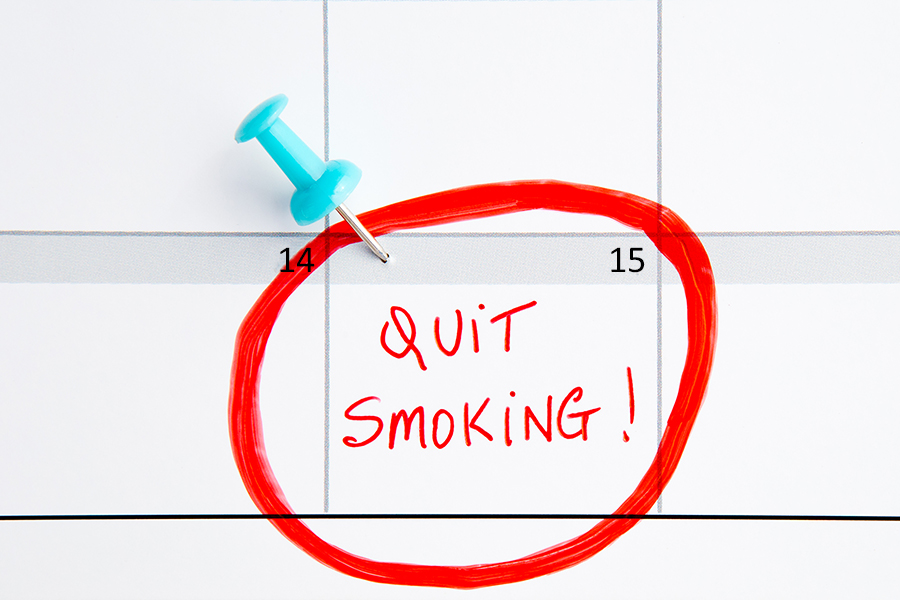Alcohol Awareness Month: Underage Drinking
Alcohol Awareness Month: Underage Drinking
Virginia Johnson, CSAPC - Substance Use Prevention Director
The National Council on Alcoholism and Drug Dependence declared April as Alcohol Awareness Month in 1987 to increase awareness and understanding of alcohol addiction. Alcohol addiction is a chronic, progressive disease, and it is fatal if untreated. In North Carolina, 15.6% of high school students report having their first drink before the age of 13 (YRBS, 2017). Youth who began drinking before the age of 15 have a 40% chance of becoming addicted, as opposed to only 7% chance if they wait until they are 21. Alcohol addiction is treatable and it is preventable, but we have to start early.
The immediate impacts of excessive drinking include blackouts; alcohol overdose; unwanted, unplanned, and unprotected sexual activity; alcohol-related car crashes; unintentional injuries, and other risky behaviors. More than 4,300 deaths occur each year in the United States due to underage drinking. According to the Youth Risk Behavior Survey (2017), 12.4% of North Carolina high school teens report currently binge drinking and 15.4% have ridden in a car with someone who has been drinking.
The long-term impacts of underage drinking are numerous, because alcohol has a devastating impact on the developing adolescent brain. Alcohol use not only impacts judgement, but it also interferes with the development of the part of the brain that controls decision-making and impulse control. The brain does not fully mature until a person is in their mid-twenties, and using alcohol at a young age can keep that area of the brain from fully developing. This can affect behaviors and decision-making ability for the duration of their lifetime. Despite these terrifying realities, about 60% of high school teens in the United States have consumed alcohol. In North Carolina, 26.5% of high school teens report being current drinkers (YRBS, 2017).
We do not share these statistics to scare you. We share them to inform you and to empower you to make a difference. Even though they may not show it on a regular basis, teens want parents to set clear guidelines and expectations. It is important to talk to your kids about the dangers of alcohol and other drugs, and about your values as a family. Considering that most children have seen adults drinking alcohol on TV or in real life before they start kindergarten, that more than 15% of NC teens have had their first drink before the age of 13, and that by 8th grade, the majority of teens have favorable attitudes towards alcohol consumption, it is never too early to begin the conversation (YRBS, 2017).
The Substance Abuse and Mental Health Services Administration recommends these tips when talking to your child about alcohol. 1.Show you disapprove of underage drinking and other drug misuse.
1.Show you disapprove of underage drinking and other drug misuse.
2. Show you care about your child’s health, wellness, and success.
3. Show you’re a good source of information about alcohol and other drugs.
4. Show you’re paying attention and you’ll discourage risky behaviors.
5. Build your child’s skills and strategies for avoiding drinking and drug use.
The conversation around alcohol needs to be ongoing. Use the opportunities of everyday life as reasons to naturally bring up the conversation. If driving down the road and a song comes on the radio about alcohol, take the opportunity for a teachable moment. If watching a TV show and a character is offered a drink, ask what are the options someone has in that situation. Roleplay the situation with your child and practice creative ways to say “no” when offered alcohol. This will build confidence in their skills and ability to abstain from consuming alcohol.
For more information on how to talk to your child visit TalkItOutNC.org or download the app, Talk. They Hear You for interactive scenarios and tips. You can also take the pledge and encourage others to take the pledge to start talking to your child about alcohol here.
If you are concerned about your drinking, the North Carolina Department of Health and Human Services has a list of medical substance use service providers throughout the state: Local Management Entities By County.
References:
Alcohol and the Adolescent Brain: Immediate Impairment, Long-Term Consequences.
Centers for Disease Control. Facts Sheets – Underage Drinking.
Centers for Disease Control and Prevention Morbidity and Mortality Weekly Report.
Starting the Conversation.
TOOLKIT: Alcohol Awareness Month.U.S. Department of Health and Human Services. Substance Abuse and Mental Health Services Administration.
Classroom Crio Lesson - The Cranium Connection
Grade Level: 6th-8th grade
Program Length: 15-45 minutes
The Poe Center has partnered with SAS through Curriculum Pathways to provide online access to health science and health education lessons at no cost to teachers across the State of North Carolina. Designed to complement its health education curriculum, the Poe Center’s programs and online content are aligned with the North Carolina Department of Public Instruction’s Healthful Living and Science Essential Standards.
Substance Use and Our Brains begins with a quick overview of the brain regions and their core functions. It takes a look at the effects of stimulants, depressants and hallucinogens on on the specific regions of the brain and how they impact the core functions. Check out our library of Crio courses today!
Featured Poe Program: #YouthCulture: Adolescent Brain Development and Addiction
Grade Level: Designed for Parents and Youth-Serving Adults
Program Length: 90 minutes

The Poe Center’s #YouthCulture workshop series is designed to empower parents and guardians by providing insight into the environment and culture around youth. The Adolescent Brain Development and Addiction session explores how the developing adolescent brain shapes perceptions and behavior, how early onset substance use affects the development of the adolescent brain, and explore ways to enhance parent-child communication. Participants will learn important skills and resources to address the trends in substance use today. All participants will receive a free packet of supportive materials and resources.
To schedule a program for your PTA, faith organization, or community, contact Susan Foster at: [email protected] or 919-231-4006.
For the Love of Vegetables
For the Love of Vegetables
Rachel Pohlman MPH, RD, LDN - Nutrition and Physical Activity Director
I think vegetables too often get a bad rap. They're called too bitter, mushy, slimy, or compared to "rabbit food." Many see eating vegetables as a burden or something to get through to get to the good stuff. How many have either heard or said, “eat your broccoli and then you can have your ice cream?” I think much of this reputation comes from people not knowing how to prepare vegetables. Many people open up a can of green beans, add fat, and cook it to mush. Not the most enticing choice. However, in honor of National Nutrition Month, I am here to say eating healthy is something to celebrate, and vegetables are simply delicious. In fact, I would say vegetables are the good stuff.
As I learn to prepare vegetables and add more fresh produce to my diet, I find that vegetables add interest to a meal. I love exploring the wide variety of vegetables that exist and learning how to prepare them. When I make taco night a vegetable-based meal, everyone is blown away with how inviting and delicious it is. Vegetables provide a great variety of color, texture, and aroma. They can add excitement and pizzazz to an otherwise dull meal.
Mom really did know best: vegetables are fantastic for our health. A vegetable-rich diet is associated with reduced risk of several chronic diseases, including heart disease. Vegetables provide vitamins, minerals, and antioxidants, all of which have important functions in the body to maintain health. By choosing a variety of colors in vegetables, we are more likely to get all the different nutrients they provide. Vegetables are also low in calories which can help with weight management. According to the CDC, heart disease remains the leading cause of death in the United States. Seeing as half of the adults in the US have high blood pressure, and 70% of American adults are overweight or obese, the benefits of a diet rich in vegetables is not something to dismiss. Produce is so important that it should make up half our plate at each meal. According to the Nutrition Action Healthletter, right now it is estimated that only about 25% of Americans meet this goal.

From artichokes to zucchini, there is no shortage of vegetables from which to choose. If you do not like one vegetable, try another. If you don’t like the way it is prepared, try it a different way. Not a fan of raw broccoli? Try it steamed and add lemon juice for seasoning. Want a sweeter vegetable? Roasting brings out the natural sugars and creates a rich flavor. Veggies can be eaten cold or hot, raw or grilled, steamed or roasted. Buy them fresh, dried, canned or frozen. Vegetables are versatile and can be used as a main dish, a side, or to enhance many dishes.
Tips to add veggies to your diet:
• Add extra vegetables to soup.
• Lettuce, tomato, onion, avocado, and shredded carrot are all great additions to a sandwich.
• Add mushrooms, peppers, and summer squash to a kabob.
• Look for ways to add veggies when eating out. Order a side of vegetables in place of fries.
• Eat raw veggies for a nice crispness in place of chips. These are especially good dipped in hummus or salsa.
• When making a recipe, increase the quantity of vegetables it calls for.
• For those who are just starting with vegetables, many veggies seem to disappear when cooked but still provide health benefits. Add spinach under the cheese of a pizza. Add shredded cauliflower to just about anything.
If you learn just one way to prepare vegetables, I highly recommend roasting. I have yet to find a vegetable that does not taste amazing when roasted. You can play around with different seasonings to give it variety. For example, curry is fantastic on roasted cauliflower.
 I have also come up with favorite ways to group veggies. In the winter, I tend to use a variety of root veggies in meals. In the summer, I cook mushrooms, bell pepper, and zucchini, which goes great with food cooked on the grill, added to sandwiches, burritos, or pasta. I also love the combination of sweet potato, bell pepper, poblano pepper, and onion to add to burritos or tacos. If I just need a quick side dish that doesn’t require a lot of attention, I may roast cauliflower, Brussels sprouts, broccoli, or kale on their own. The recipe below is an all-purpose starting point to get you going.
I have also come up with favorite ways to group veggies. In the winter, I tend to use a variety of root veggies in meals. In the summer, I cook mushrooms, bell pepper, and zucchini, which goes great with food cooked on the grill, added to sandwiches, burritos, or pasta. I also love the combination of sweet potato, bell pepper, poblano pepper, and onion to add to burritos or tacos. If I just need a quick side dish that doesn’t require a lot of attention, I may roast cauliflower, Brussels sprouts, broccoli, or kale on their own. The recipe below is an all-purpose starting point to get you going.
Roasted Vegetables: an all-purpose recipe that everyone needs to know
Ingredients
- 4 cups vegetables
- 1-2 onions
- 2-4 garlic cloves (or sprinkle garlic powder)
- 3 Tablespoons olive oil
- ½ tsp salt
- ½ tsp pepper
- Other herbs to taste (red pepper, thyme, sage, rosemary are all nice)
Instructions
- Preheat oven to 400.
- Cut vegetables into bite-size pieces, about 1-inch square (smaller pieces will reduce the cooking time. Larger pieces increases cooking time).
- Add chopped vegetables to a large bowl.
- Lightly coat with olive oil.
- Add seasoning to taste.
- Lay in a single layer on a baking sheet.
- Bake 20 minutes.
- Toss.
- Return to oven and bake until golden and to desired tenderness. They are done when tender and brown.
Check out this recipe for roasted cauliflower.
Sources:
Nutrition Action Healthletter, Center for Science in the Public Interest.
Academy of Nutrition and Dietetics, National Nutrition Month materials.
Leading Causes of Death, Center for Disease Control.
Classroom Activity - Eat a Rainbow Taste Test
Grade Levels: K-5th grade
Different produce provides different nutrients your body needs. By eating a wide variety of fruits and vegetables, you ensure that your body is getting different nutrients. An easy way to do this is to fill half your plate with fruits and vegetables and by eating a rainbow! Familiarize students with fresh fruits and vegetables by holding an "Eat a Rainbow" taste test in your classroom. This activity can be done in one sitting, or you can try a new color each day of the week.
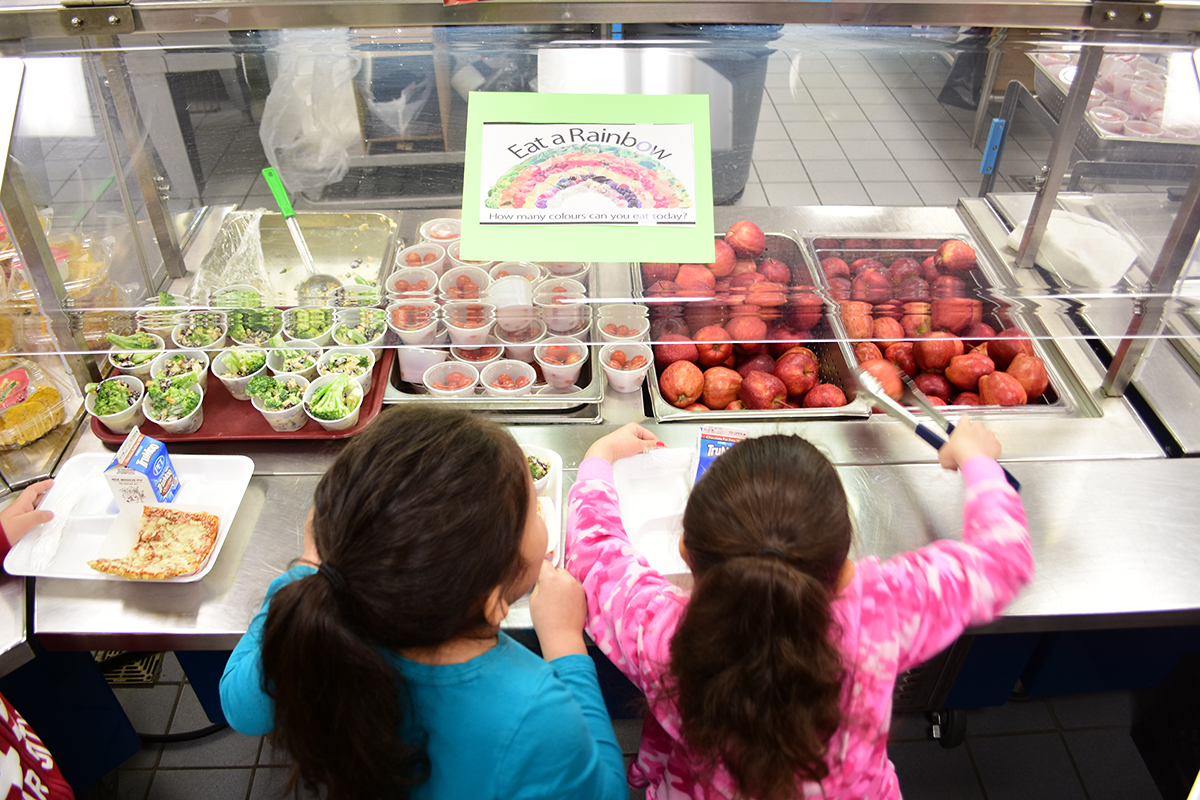
“Red” – strawberries, grape tomatoes
“Orange” – carrots, oranges
“Yellow” – bananas
“Green” – spinach
“Blue” - blueberries
Have older grades research the health benefits of each color of produce and find a fun fact for the color of produce.
Use a taste-test worksheet where kids can record their observations about color, texture, flavor, and if they liked the taste or not.
Remember, never force a child to eat something they do not want. If a child is unsure about tasting one of the items, allow them to touch it, smell it, maybe even just touch it to their tongue. Giving a child time to become familiar with a new food will help to increase acceptance of it later on.
After children have experimented with tasting all the foods, have them sign this certificate to show they tried eating a rainbow!
Featured Poe Program: Cooking in the CookWELL Kitchen
Grade Level: Contact the Poe Center for details
Program Length: 1 - 2 hours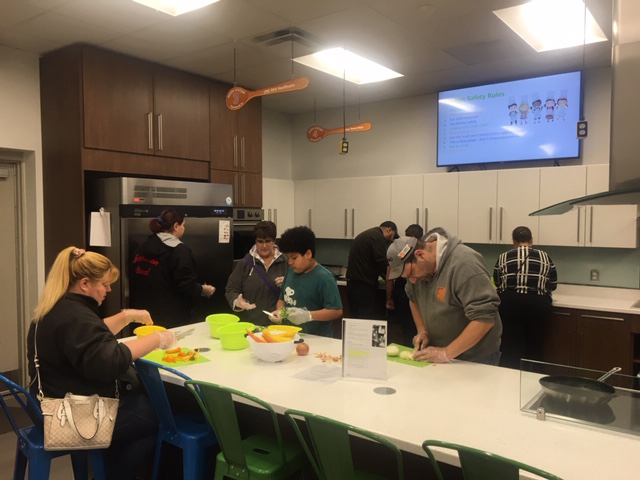
The CookWELL teaching kitchen allows people of all ages to learn hands-on cooking and nutrition skills. Participants learn basic kitchen safety, nutrition, and make a simple, healthy, and delicious dish. Programs are led by ServSafe-trained professionals using an evidence-based curriculum. The CookWELL Kitchen can accommodate up to 25 people and has 4 workstations.
Schedule a visit online or call 919-231-4006.
Reducing Sugar Snacking for a Healthy Smile
Reducing Sugar Snacking for a Healthy Smile
Alaina Hart MPH, CHES - Senior Health Educator
“If you keep eating that, you will rot your teeth out!” Growing up, many of us heard this warning about sugary foods, and we may be repeating it to our children. Though the phrase sounds exaggerated, it is based in fact. Now, more than ever, children have greater access to sugary snacks. According to the Department of Health and Human Services "sugar is the most popular ingredient added to food in the U.S.” On average, Americans consume about 152 pounds of sugar each year, which is about 6 cups of sugar per week. Bacteria in the mouth use the sugar in drinks and food to produce acids which causes tooth decay.
February is Children’s Dental Health Month, which is a great time to explore ways to reduce sugar snacking and promote healthy habits.
We know that brushing, flossing, and visiting the dentist regularly is a great recipe for a healthy mouth. Paying attention to the foods children consume and keeping their teeth in mind when choosing drinks and snacks also makes a big difference in their dental and overall health. Here are four ways to reduce sugar in your diet for a healthier, brighter smile.
1. Read the fine print. Watch out for added sugars.
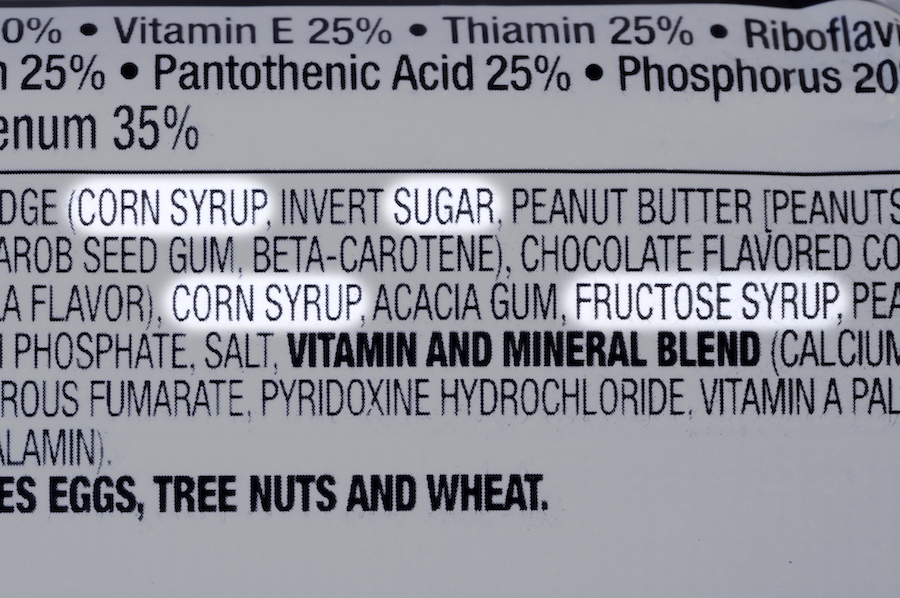
Don’t worry about the natural sugars found in fruits and some dairy products. Packaged or processed snacks and meals, however, may have added sugars, which can be dangerous when consumed in large amounts. The American Heart Association recommends that children ages 2-18 years old should have less than 25 grams or 6 teaspoons of added sugar a day.
Almost all foods contain sugar, so it's almost impossible to eliminate every food with sugar. Foods with natural sugars may also contain important nutrients and vitamins that our bodies need. Natural sugars can enhance flavor. To determine which foods have added sugar, read nutrition labels carefully. Many food labels now have the line “added sugars” to help differentiate between naturally occurring sugars and added sweetener. Keep this in mind and work towards a balanced diet for you and your kids.
2. The real squeeze on juice and soda.
Juice, even 100% fruit juice, tends to be higher in sugar and calories when compared to eating actual whole fruits. The American Dental Association suggests that water and milk are the best drink options for little ones and should be offered before juice. The American Academy of Pediatrics suggests that “children under one year old should not have fruit juice in their diet at all.”
What's the verdict? When you can, try making whole fruit a priority over juice and limit the amount of juice children drink. For tips on how to add more fruit into your daily diet, check out this site.
But what about soda? Soda provides no nutritional value, is full of sugar and calories, and can lead to tooth decay. If your child is craving a bubbly drink, the American Dental Society suggests sparkling water as a good alternative to soda: “sparkling or not, plain water is always the best choice.”
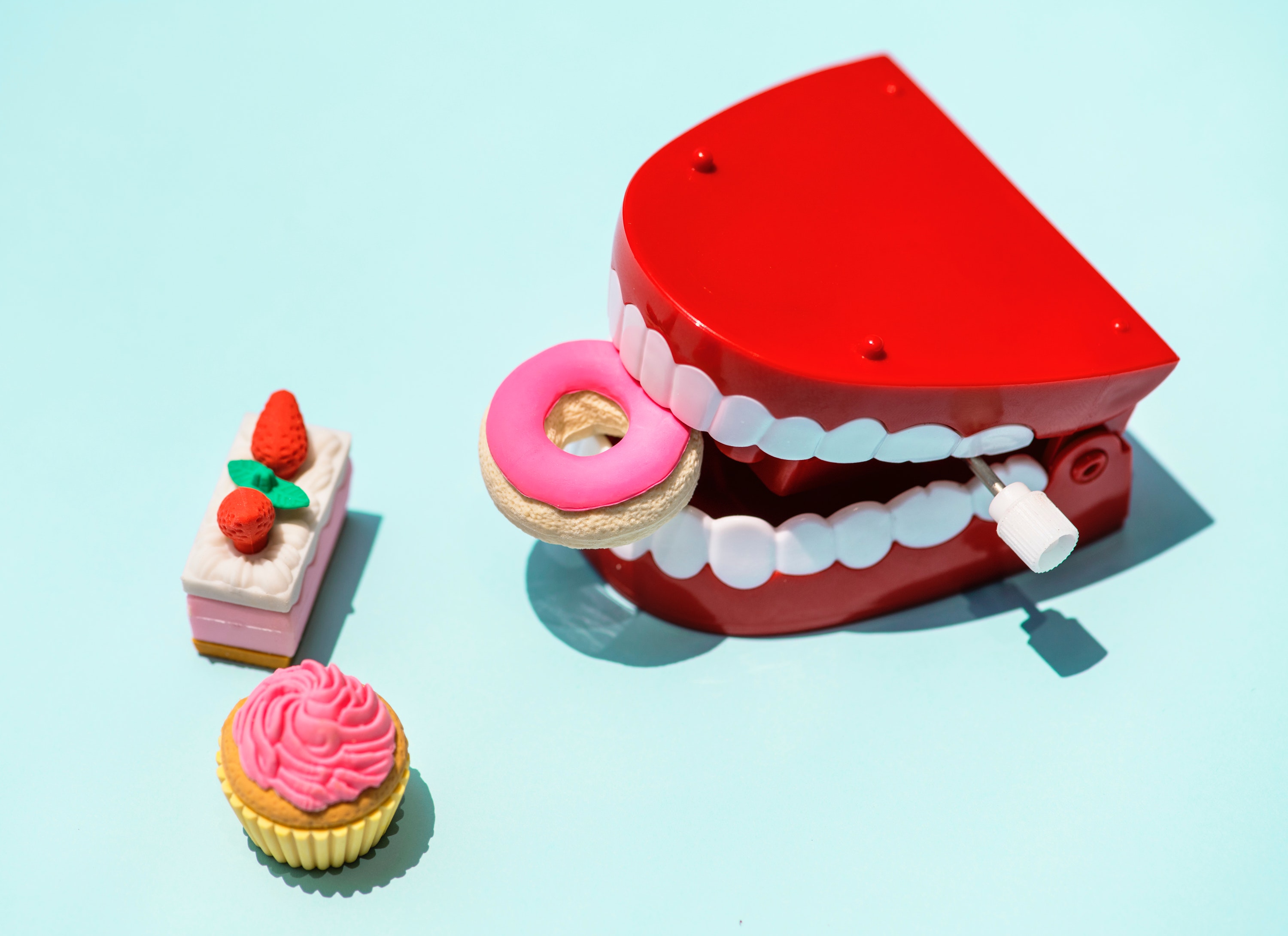
3. Tricky sticky foods.
When it comes to snacking, sticky foods are not your teeth’s friend. Parents are often surprised to learn that sticky snacks, such as dried fruit, have a sugar content that is closer to candy than it is to fruit. Dried fruit and fruit snacks pose potential problems for teeth because they stick to teeth longer than other foods. Though these are promoted as healthy snack options, eating these should be followed by good brushing and flossing.
4. Lead by example.
Want to help children develop good dental health habits? These habits start with role models. From brushing and flossing to making healthy food choices, children will mimic their caretakers’ habits. Find fun and creative ways to involve the whole family in building healthy habits for a healthy mouth and body. The ADA has fun tips to make brushing fun for kids. Involving your children early and often with these tips in mind will help your kids on their way to a healthy smile that will last a lifetime.
Resources:
American Academy of Pediatrics Recommends No Fruit Juice for Children Under 1 Year
American Dental Association: 6 Ways to Reduce Your Child’s Sugar Snacking
How Much Sugar Do You Eat? You May Be Surprised.
Is Sparkling Water Bad for My Teeth?
Keep Gruits Handy. United States Department of Agriculture.
Sugar Recommendation for Healthy Kids and Teens
Classroom Crio Lesson
The Poe Center has partnered with SAS through Curriculum Pathways to provide online access to health science and health education lessons at no cost to teachers across the State of North Carolina. Designed to complement its health education curriculum, the Poe Center’s programs and online content are aligned with the North Carolina Department of Public Instruction’s Healthful Living and Science Essential Standards.
Healthy Teeth, Healthy Smile
Grade Level: K-5th grade
Program Length: 15-45 minutes
This lesson breaks down the different parts that make up the tooth, how and why cavities form, and tips to keeping teeth clean. Check out our library of Crio courses today!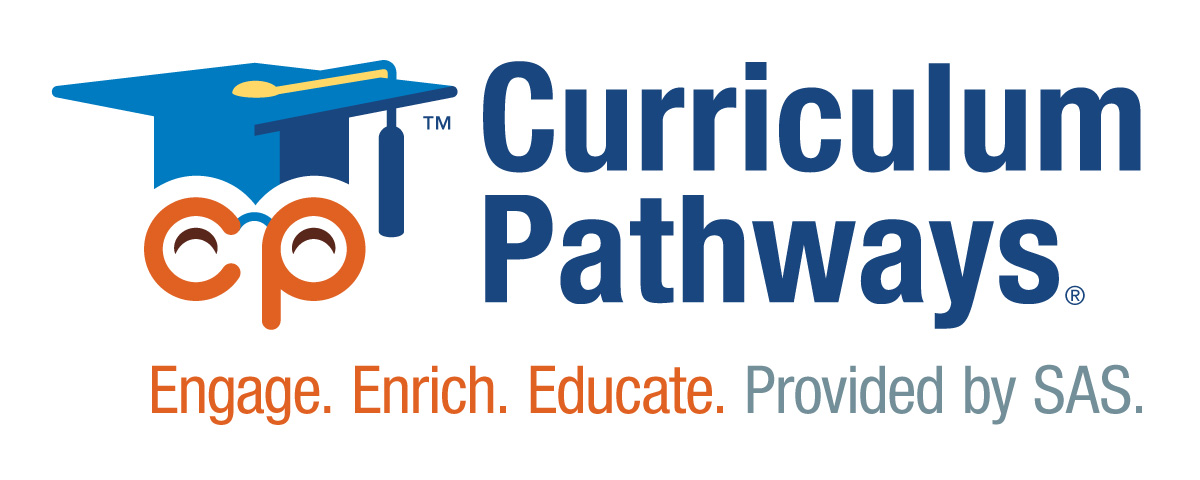
Featured Poe Program: Sheriff Tuffy Tooth
Grade Level: Preschool - 1st
Program Length: 30 minutes
Sheriff Tuffy Tooth really speaks to kids about the importance of tooth brushing, eating healthy foods, and visiting the dentist. Invite the Sheriff, an animated talking tooth and his deputy “Bucky the Horse” to visit your school or group for a one-of-a-kind experience!
Schedule a visit online or call 919-231-4006.
Resolve to Talk with Your Kids about Sex: Four steps to better communication.
Resolve to Talk with Your Kids about Sex: Four steps to better communication.
Robin Pittman - MS, CHES
Happy New Year! If you are like me, you probably have a list of resolutions for 2019. In addition to common resolutions such as becoming healthier and more active, I am resolving to inspire parents to have more conversations with their kids about their bodies and about sexuality. Many of us are already talking to our children about their day or their classes, but we need to go deeper with those talks. In this social-media hyper-focused world, kids are seeing and hearing messages about sex, relationships, and dating, and the majority of the information they are hearing is skewed at best, and sometimes just plain wrong. Parents need to be proactive on this topic.
When discussing sex, relationships, and dating, society presents a dichotomous view: fear and shame on one hand and glamour and glitter on the other. This causes the topics of sex to be confusing for kids. Parents are often scared to talk about sexual health fearing that the conversation may cause their children to prematurely engage in sexual activities. However, the research suggests that the more sex education children receive, the less they are to actually engage in sexual activity.
In fact, kids who lack the knowledge about the benefits of delaying sex tend have sex at an earlier age and have more sexual partners. According to research from the Guttmacher Institute, comprehensive sex education helps teens delay sex and helps with other related decisions such as selecting partners and using contraceptives. This fact is a game-changer for a lot of parents as delaying sex tends to be a major focus when raising adolescents.

With the increase of comprehensive sex education in school systems across the country, teen pregnancy rates have dropped dramatically since the 1990’s. If parents can partner with their school systems by continuing to talk about sexuality at home, rates are likely to drop even more.
The key message here is to keep talking about sexuality with pre-teens and teens. It works. Let’s do this together by letting our youth know the truth about their growing bodies so they can make smart, informed decisions.
Here are some tips to help guide you through this topic as you open your minds and mouths and make 2019 a great year of communication between you and your child.
1. It is not the child’s responsibility to start this conversation.
If your child approaches you with questions, that is wonderful! You have made yourself approachable. Being an approachable parent means your kids are comfortable with you and see you as a reliable resource for answers. Always let your child know you are there to answer questions, and be open and honest with your response.
However, most kids are not going to run to their parents every time they hear something they are confused about in regards to sexuality. So take the lead by starting the conversation. Check in with them. Discuss messages they hear in movies, television, and music that refer to sex and relationships or human growth and development. Let them know you are here and willing to answer questions. If you are not entirely comfortable with the topic, practice what you want to say first. The more you talk, the easier the conversations will become.

2. Start the conversation early.
The earlier the better! Talking about sexuality when they are young means more complex conversations will be easier as they get older. If you start talking about sexuality with your child at a young age, you and your child will be more comfortable discussing the topic and more complex issues by the time your child reaches adolescence. Wait until their teens, and the chances of your child being uncomfortable and closed off increases. Each time you have a conversation with your child, a sense of comfort builds, and you open the door for them to keep having these conversations. They will look to you as a guide from a young age.
So what does “sex ed” look like for young ages? Sex education for kids ages 5-6 should teach them about body parts by using the correct anatomical names. Answer all their questions. Try not to avoid them. Questions might be simple like, “Why do adults kiss?” or “Why do people get married?” Keep responses simple and straightforward, and you will open a life-long dialogue about this tough topic.
For more information on this and age by age guide, click on this link.
3. Talk comprehensively.
When talking about sex and sexuality during the middle and high school years, it is important to include a range of topics. A comprehensive discussion includes family values and morals, sexual intercourse, reproductive systems of males and females, peer pressure, sexually transmitted diseases, healthy relationships, sexual assault and harassment, and contraceptive methods.
Remember, knowledge is power. Informed kids will make informed decisions about their sexual health and relationships. The more kids know, the better equipped they will be to make the right decisions.
4. Get help.
You are not in this alone. There are several great books that can guide your family through these discussions. Books alone won’t be as effective as a conversation, but they serve as a supplement, providing more in-depth information. Titles such as It’s So Amazing, The Ultimate Girls Body Book and The Ultimate Boys Body Book are great resources. The Poe Center also is offering a mother-daughter workshop called Girl Talk on March 3rd at 9:00 a.m. Find more information below.
(2012). Sex Education Linked to Delay in First Sex. Guttmacher Institute.
(2017). What is Behind Teen Pregnancy Rates? Guttmacher Institute.
Classroom Crio Lesson
The Poe Center has partnered with SAS through Curriculum Pathways to provide online access to health science and health education lessons at no cost to teachers across the State of North Carolina. Designed to complement its health education curriculum, the Poe Center’s programs and online content are aligned with the North Carolina Department of Public Instruction’s Healthful Living and Science Essential Standards.
Healthy Relationships 101
Grade Level: 9th-12th grade
Program Length: 15-45 minutes
Healthy Relationships 101 explores the facets of what makes a healthy relationship. Setting and communicating personal boundaries, identifying warning signs of unhealthy relationships, and identifying societal influences that impact relationships are discussed through engaging activities, multi-media, and thoughtful reflection. Check out our library of Crio courses today!
Poe Program: Girl Talk: Mother-Daughter Workshop
Grade Level: 4th – 7th
Program Length: 2 hours
Girl Talk addresses the timely topic of adolescent growth and development and the physical, social and emotional changes that girls experience during puberty. 3-D theater exhibits, hands-on activities, movies and candid discussions help moms and their daughters explore a range of topics from the workings of the reproductive system to the menstrual cycle to feminine hygiene protection & more. Girl Talk has been specifically designed with activities that foster and encourage open mother-daughter communication.
This workshop is being offered at the Poe Center on Saturday, March 2, 2019 from 9:00 am to 11:00 am. Registration is $25.00 for each mother & daughter pair, and $10.00 for each additional daughter.
To register, contact Robin Pittman at: [email protected] or 919-231-4006
Don’t wait until New Years. Make exercise a priority now!
Don’t wait until New Years.
Make exercise a priority now!
Cammie Bates - MPhys, LAT, ATC
As I reflect on this year and look ahead to what is next, I can’t believe we’re already in the holiday season. The older I get, the more I realize how much there is to do between Thanksgiving and New Years and how self-care can fall off the radar if I don’t make it a priority.
The holiday season can feel like a sprint, and before you know it, it’s New Years. There are parties to attend, gifts to purchase, food to make, and traditions to enjoy. Then it's time to make to make resolutions. Yet in all the hustle and bustle, you must continue to carry out daily obligations: jobs, household chores, and families to take care of. Some might even say the holidays are overwhelming and downright stressful. So while this season can bring so much joy and make happy memories, let’s not forget to slow down a little and make sure to take care of ourselves. For me, self-care means making exercise a priority now and not waiting until the New Year.
A study out of Texas Tech University found the average American gains 1.5-2 pounds during the holiday season. Over 10 years, this can lead to 20 pounds of added fat (DoveMed, 2015). While the study noted that exercise did not impact the amount of weight gained, it’s important to remember the many benefits exercise provides. Regular exercise helps combat the damaging effects of cortisol, which is released with stress and can be particularly high this time of year. Exercise increases blood circulation and brain activity, which helps to think more clearly. It positively impacts the hippocampus, which improves memory. Exercise also releases endorphins, the feel-good hormones. These endorphins can be essential during the holidays. So if you’re feeling really stressed, try some physical activity. It can really help.
There is no one-size-fits-all approach to staying active during the holidays, but here are a few tips to work physical activity into the holiday routine without having to find an extra 1-2 hours a day at the gym. Remember every little bit of movement helps.
- Make gatherings active! Take everyone for a walk to see the holiday lights or go ice skating.
- Park further away when shopping for presents or running errands to get in a few more steps.
- Sneak in a quick workout while baking or cooking by using cans as weights or the counter for pushups. Cooking a turkey or ham? Those can be quite heavy and a great weight for some squats or lunges.

- Try a holiday-themed run. Many are family-friendly.
- If guests are coming over, clean the house for a quick workout. Turn on the music while you're at it for an impromptu dance party.
- Speaking of guests, encourage them to bring activewear so everyone can participate in physical activity, such as an after-meal walk or post-party yoga.
- With the colder and darker weather, stay safe and warm with reflective layers and carry lights to make yourself visible.
- If traveling, plan ahead to walk the airport during long layovers. If driving, stop every few hours to stretch and move. Avoid vending machine and fast-food one your trip by packing healthy snacks, such as apples or almonds.
Remember, part of the joy of the holidays is a change from our normal routine. Missing a few workouts here and there won’t make you unhealthy. Eating a second helping or a few extra cookies won’t make you unhealthy. The key is to not let a few days of indulgence turn into indulging the entire holiday season. Being active and eating well is a lifestyle, so enjoy the holidays!

At the Poe Center, we’re in the middle of a simple, seven-week Winter Wellness Challenge. Staff are trying to get the USDA-recommended 150 minutes of physical activity each week. For the 25 participating, that means a total of 1050 minutes over the holiday season. It’s doable and reminds us that every little bit of activity helps. It helps not only physically, but also mentally. And for me, that’s just as important during this holiday season.
Join us and make exercise a priority now, not only after the New Year.
(2017). Sport and Physical Activity to De-Stress the Holidays. SIRC
(2018). Healthier Holidays in 1 – 2 – 3!. National Center for Chronic Disease Prevention and Health Promotion, Division of Nutrition, Physical Activity, and Obesity.
(2015). ‘Holiday Stuffing’ May Be Responsible For Annual Weight Gain'. DoveMed.
(2011). Ways to be Active When the Whole Family Gets Together for the Holidays. SPARK
Classroom Activity: Re-energize Your Class
Adults are not the only ones who need to be active. In fact, the USDA recommends kids aged 6-17 should be engaging in 60 minutes or more of moderate to vigorous physical activity every day (2018 Physical Activity Guidelines). The key to keeping youths active is to make it fun and have a variety of activities. Brain breaks or classroom energizers are 1-5 minutes and positively impact physical health, improve classroom behaviors, and leave students focused and ready to learn. Active kids learn better. Try these tips and energizers, and check out the websites below for more ideas.
- When teachers participate in the activity, students are more likely to join. Get the entire school involved by encouraging the administration to play music after announcements to get everyone dancing.
- Think about ways to incorporate inexpensive equipment such as bean bags, erasers, plates, yoga balls, etc.
- Empower students to choose and lead the activities. Explore ways to get everyone involved.
- Don’t forget simple activities such as balancing, stretching, or breathing exercises as a way to refocus and calm nerves, especially around test time.
- Try the game 5-4-3-2-1. “In this simple game, students stand up, and the teacher (or leader) has them do five different movements in descending order. For example, the teacher would say: ‘Do five jumping jacks, spin around four times, hop on one foot three times, walk all the way around the classroom two times, give your neighbor one high-five’ (pausing in between each task for students to do it).” (Lynette 2012).
- Consider the game “As If” for K-3rd graders. In this game, a teacher will read a statement and students will act it out. For instance: “Run as if a bear is chasing you. Jump as if you are popcorn popping” (Eat Smart Move More 2015).
Resources:
(2017). Classroom Energizers at School. Action for Healthy Kids.
(2012). “20 Three-minute brain breaks.” Lynette, Rachel.
(2015). K-5th Classroom Energizers. Eat Smart Move More.
Classroom Crio Lesson
The Poe Center has partnered with SAS through Curriculum Pathways to provide online access to health science and health education lessons at no cost to teachers across the State of North Carolina. Designed to complement its health education curriculum, the Poe Center’s programs and online content are aligned with the North Carolina Department of Public Instruction’s Healthful Living and Science Essential Standards.
Play Hard, Stay Fit
Grade Level: 2nd - 3rd grade
Program Length: 15-45 minutes
Play Hard Stay Fit is an online course aimed at equipping 2nd and 3rd-grade students with skills and abilities to make healthy physical activity and eating choices. Students will examine the question “What is exercise?” and learn to understand what it means to treat your body in a healthy way. Students will engage in online activities to discover their personal likes and dislikes, learn to make healthy decisions, explore how physical activity benefits every aspect of their lives, and better understand the risks of making unhealthy decisions. Check out our library of Crio courses today!
Poe Program: “FITT” for Life
Grade Level: 4th – 5th
Program Length: 60 minutes
You’ll feel great after taking this program as we introduce the importance of regular physical activity. Participants will experience the balance between eating and exercise while reinforcing the benefits of an active lifestyle. This program introduces the different levels of exercise as well as the components of a good athlete. We encourage participants to make a lifelong commitment to their health.
The Poe Center offers over a wide variety of nutrition and physical activity programs for all ages. Call 919-231-4006 or go online to plan a program.
The Great American Smokeout
The Great American Smokeout
Virginia Johnson - CSAPC
It is that time of year again, the time when we pause to think about all the things we are thankful for in our lives, the time when we think about how much our loved ones mean to us, the time when we think about what we can do to help our friends, families, and colleagues live longer healthier lives. It’s time for the Great American Smokeout.
The American Cancer Society has hosted the Great American Smokeout every third Thursday of November for more than 40 years. To learn more about the benefits of quitting smoking and to learn more about how you can get involved in the Great American Smokeout, click here.
Smoking is a difficult addiction to overcome. However, people do successfully quit and begin to feel the benefits immediately. If you or a loved one needs help to quit smoking, visit www.QuitLineNC.com or call 1-800-Quit-Now. QuitlineNC provides resources, tools, and tips for those on the path to quitting smoking including free cessation services and coaching. If you are thinking about quitting, take the “Do You Need Help Quitting?” quiz to determine your level of nicotine addiction and receive tips on a cessation plan to meet your needs.
Smoking rates in the United States have been on the decline, but smoking is still the leading cause of cancer and continues to be a contributing factor in 1 out of every 5 deaths. It is never too early or too late to quit smoking. The benefits of quitting smoking start immediately with a decrease in blood pressure, not to mention better-smelling breath, hair, and clothes. A few weeks later, circulation improves, sense of smell returns to normal, and food begins to taste better. A few months later coughing and shortness of breath decrease. After 5 years, risks of certain cancers are cut in half.
Although traditional cigarette smoking is on the decline, electronic cigarette use is on the rise. Electronic cigarettes, often referred to as, e-cigarettes, e-cigs, or vapes, are electronic devices that heat a liquid containing nicotine and special flavors to produce an aerosol that is breathed into the lungs. The aerosol can also be inhaled by bystanders. They come in lots of shapes and sizes. Some examples are included below.
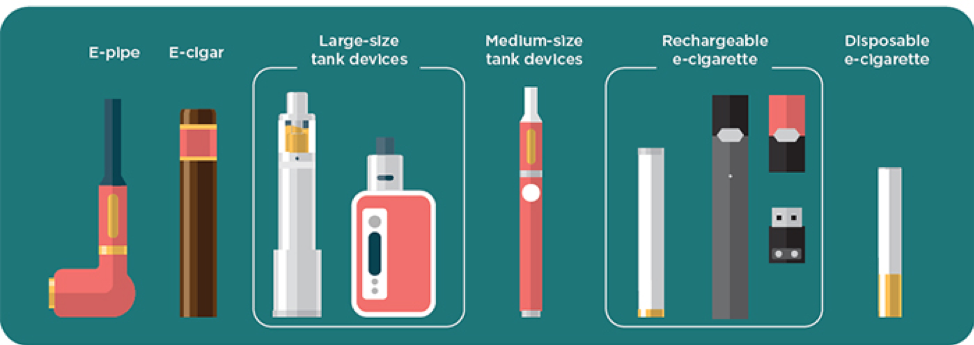
Testing on long-term health effects are still being conducted, however we already know that e-cigarettes are not safe, contain cancer causing chemicals, and are harmful on the adolescent developing brain. Most e-cigarettes contain nicotine, the same addictive drug found in traditional cigarettes. E-cigarette devices can also be used to deliver other drugs such as marijuana.
For more information on electronic cigarettes and teens, download the Talk with Your Teens About E-cigarettes: A Tip Sheet for Parents provided by the Centers for Disease Control and Prevention Office on Smoking and Health.
Questions about the impacts of nicotine on adolescents? Questions about effects of e-cigarettes? Host or sign up for the Poe Center for Health Education’s #YouthCulture: Vaping 101 program.
Resources and References:
The Great American Smokeout. American Cancer Society. Retrieved on 11.1.2018.
Talk with your Teen About E.Cigarettes: A Tip Sheet for Parents. Office of the Surgeon General. Retrieved on 11.8.2018.
Quick Facts on the Risks of E-Cigarettes for Kids, Teens, and Young Adults. Centers for Disease Control and Prevention. Retrieved on 11.5.2018.
For the Classroom: Smoking Lungs Simulation
Take this topic back to your students with this educational activity.
Objective: To demonstrate the decreased lung capacity of smoking.
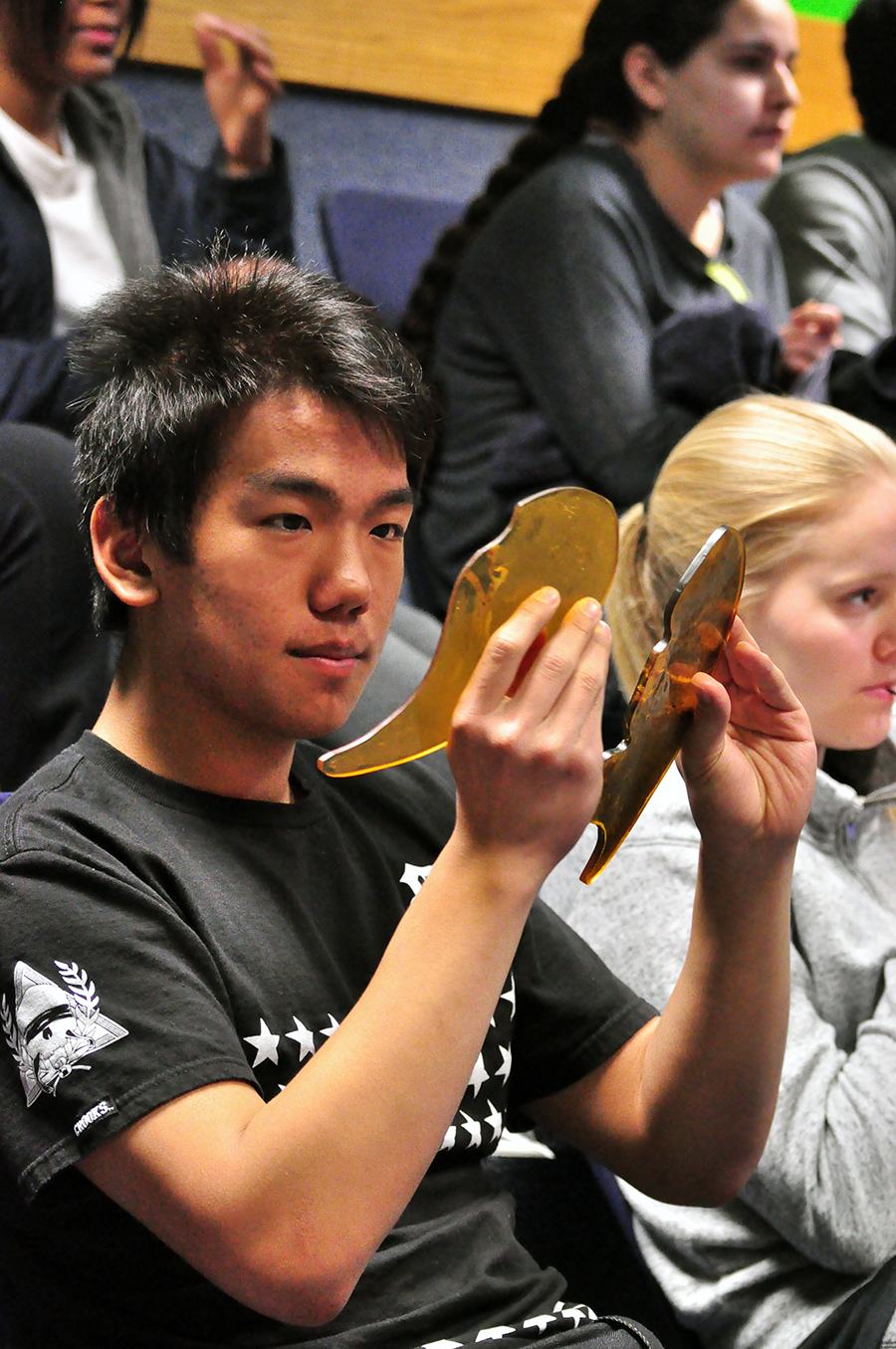
Supplies:
Coffee Stirrer Straws
Activity:
1. Ask the class to do 10 jumping jacks or other short aerobic activity, such as running in place.
2. Ask how they feel afterwards. Common answers include energized, awake, or just laughter.
3. Pass out coffee stirrers.
4. Ask the class to do 10 jumping jacks. As soon as they are finished, have them breathe through only the straw for 5 seconds. (Caution: this is not an activity for anyone with asthma or respiratory challenges).
Key Points and Process Questions:
Ask how they feel now.
This simulates the feeling of someone’s lung who is a heavy smoker. Who do you think can run faster – someone who smokes or someone who does not smoke? Why?
What other physical activities do you think may be limited by heavy smoking use?
Additional Great American Smokeout information and teacher activities can be found at SmokingStinks.org
Featured Poe Program
Featured Program: #YouthCulture: Vaping 101
Audience: Parents and Adults who Work with Youth
Program Length: 90 Minutes

#YouthCulture: Vaping 101 addresses the growing concern about e-cigarettes and youth. Participants will explore adolescent brain development and effects of e-cigarettes as we cover the latest research. We will also take a look at the risk factors for use and the protective factors that help prevent use. A discussion on resources and strategies to increase protective factors for our youth will leave attendees with tools for next steps.
Interested in bringing this topic to your school or organizations? The Poe Center’s Substance Use Prevention curriculum offers programs for 3rd-12th grades and adults. Book a program online or call 919-231-4006.






